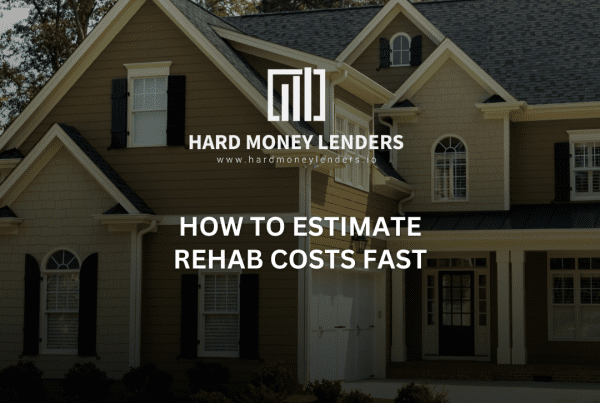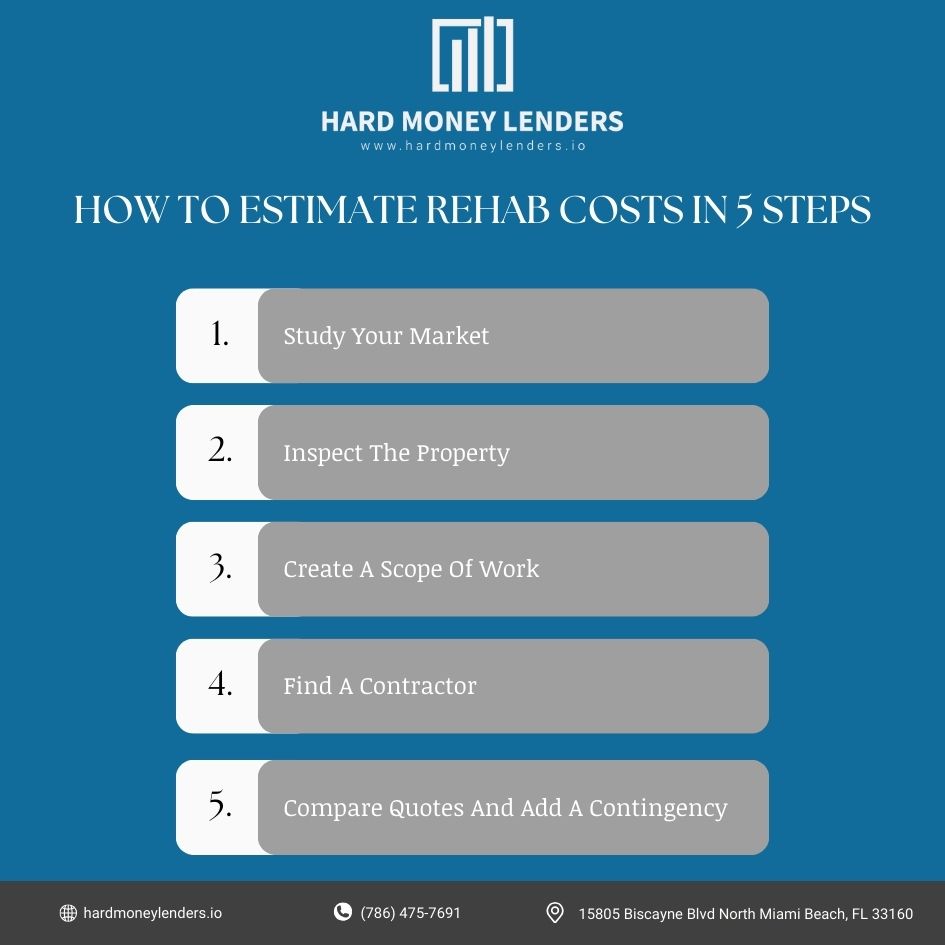How to Estimate Rehab Costs Fast

If you have considered investing in real estate, or if you’re a seasoned investor with years of experience, you’re probably aware that any fix-and-flip property that you purchase will likely come with a number of renovations that need to be made to it. The most successful house flippers are able to determine what type of work will need to be done beforehand, how much time it will take to rehab the property, and most importantly how to estimate rehab costs.
Below, we’ll show you how to estimate rehab costs for potential investment properties so that you can have a solid understanding of what you’re committing to before purchasing a property. Keep in mind that all real estate investment scenarios are unique and have different needs and requirements depending on the circumstances.
What Are Rehab Costs In Real Estate?
Rehab costs in real estate refer to all expenses related to renovating and preparing a property for sale or rent. This includes the purchase of materials, hiring of labor, and the use of various tools and equipment. Typically, rehab costs can be broken down into several key categories:
- Materials: This is often the largest part of rehab costs and can include everything from paint and plaster to fixtures and fittings. The quality and cost of materials can vary significantly based on the desired finish and the property’s location.
- Labor: The cost of labor depends on the complexity of the projects and the local wage rates. It includes payments to contractors, subcontractors, and any temporary workers hired to complete the project.
- Tools and Equipment: Some rehab projects may require specialized tools or heavy equipment that might be rented or purchased outright, adding to the overall cost.
- Design and Architecture Fees: For more extensive renovations, professional fees for architects or designers may be necessary.
- Permits and Licenses: Depending on the locality, you might need to pay for various permits or licenses to legally carry out construction and renovation work.
Why Should You Estimate Rehab Costs Before Purchasing An Investment Property?
Estimating rehab costs before purchasing an investment property is essential for several reasons:
- Financial Planning: Knowing the rehab costs helps investors create a realistic budget, which is crucial for managing cash flow and securing financing.
- Assessment of Potential Profit: Accurate cost estimates help investors analyze the potential profit or loss from a project. This is vital for decision-making and assessing the viability of an investment.
- Project Scope Definition: Early cost estimation helps define the scope of the project. Investors can decide which renovations are necessary and which can be deferred, based on their budget and the expected return on investment.
- Risk Mitigation: By estimating the rehab costs, investors can identify potential financial risks early in the process. This can include unexpected increases in material costs or discovering more extensive damages that require additional funds to repair.
- Negotiation Leverage: With a clear understanding of rehab costs, investors are better positioned to negotiate the purchase price of the property. If the estimated rehab costs are high, this might justify a lower offer price to ensure profitability.
How To Estimate Rehab Costs In 5 Steps
 Step 1: Study Your Market
Step 1: Study Your Market
The first step in estimating your rehab costs is to determine what actually needs to be done to the property. Before you start calculating rehab costs, it’s important to have a vision of what the final product will look like. Depending on what level of finish you or your buyer are aiming for, your renovations could take as little as a couple of days, or as long as a few months.
Pulling comps in your area is an excellent place to start. Search real estate websites (like Zillow or Trulia), attend open houses, or check out public property records to see what other homes in the area are listed for and what features they have. After determining the standard in your area, you can decide whether or not you want to renovate above or below it.
After pulling comps, use these to develop a list of repairs and upgrades that a potential property will need in order to make a profit when you decide to sell it.
Step 2: Inspect The Property
Once you determine that the property has the potential for profit, the next step is to perform a detailed property inspection. This walkthrough inspection should give you an in-depth look at what needs to be fixed in order to legally rent or resell the property in your area. It is also a critical part of the due diligence process for any home purchase and is usually required by a lender.
During this process, it’s important to look out for any major problems, like a roof that needs to be repaired, cracked foundation, mold, HVAC issues, and termites. These rehab tasks can quickly put your budget in the hole if they aren’t factored in initially. You also can’t truly understand the full renovation scope if you don’t know all of the issues hidden within the house.
Step 3: Create A Scope Of Work
A scope of work is a detailed list of all of the renovation projects and repair work that will be performed at a property. There are many factors to include when constructing this list, such as:
- Interior and exterior paint – Even if the paint is in good shape, it may be necessary to switch to more modern or neutral colors. Fortunately, paint is usually one of the most cost-effective upgrades that can be made to a property.
- Flooring – Tile pieces that are cracked and carpet that is worn in will definitely need to be updated. Hard-wood flooring may also need to be replaced or repaired depending on the condition it is in.
- HVAC – Heating, Ventilation, and Air Conditioning. Your real estate agent should have information on how old the system is, which can help you decide whether or not to replace it. If it is in good working condition, you probably don’t need to replace it, which will save you a significant amount of money.
- Roof work – The age and condition of a roof can have a large impact on how much you’re able to sell a house for. If there are holes or leaks in the roof, this is something you’ll want to take care of before selling the property.
- Electrical and lighting – If your home inspector flags any electrical items, you’ll want to prioritize the repairs above nearly every other item on the list. Renting a home with faulty wiring is illegal in most cities, and if you’re trying to flip the property be aware that many buyers will walk from a home that has electrical issues.
- Plumbing – Your home inspector should make you aware of faulty pipes and existing water damage. Be careful when picking projects to repair water damage. Covering up evidence of this damage can get you in a lot of trouble down the line.
- Baths, including cabinetry and fixtures – Modernizing cabinets can sometimes be as simple as painting them. Talk to your contractor about rehab options.
- Kitchen, including appliances and countertops – Consider the type of appliance that is being purchased and the finish for the countertop carefully. Expensive items in a lower-end home are often a waste of money, while cheap items in a higher-end home will make it very difficult to sell.
- Landscaping, sheds, and porches – Carefully consider whether it makes sense to rehab or demolish damaged out-buildings.
- Pools – These usually require a different contractor who specializes in pool repair if repairs need to be made.
- Pest control, including correction of damage from termites.
When compiling your list, you should also consider these questions that many real estate investors often overlook:
- What is the condition of the flooring? Can carpets or laminate simply be cleaned, or do they need to be replaced?
- Are the walls in good condition? What needs a new coat of paint?
- Are the kitchens and bathrooms up-to-date? Can they be made more modern with paint, or are there features that need to be torn out and replaced?
- What is the condition of the landscaping?
- Are there any other obvious items that need to be removed, cleaned up, or replaced?
Your scope of work will vary greatly based on whether you intend to rent out the house or flip it. Houses that are going to be upgraded in a few weeks or months and resold will need to have a rehab budget that focuses on cosmetic upgrades.
The purpose of these investments is to improve a property so that it can sell for a higher price than it was purchased for. That means the focus needs to be on upgrades that add to the perceived value of a property.
Step 4: Find A Contractor
If you plan on hiring labor for your home renovations, your next step is to start interviewing contractors. Good contractors can often be found through recommendations from your real estate network, online resources, or even the recommendation of your real estate agent. Make sure to thoroughly consider customer reviews when selecting contractors to help rehab your property.
Step 5: Compare Quotes And Add A Contingency
The final step in the rehab cost estimating process is collecting quotes for every renovation on your list. When comparing these quotes, it isn’t ideal to simply choose the lowest bidder for each project. Availability of the contractor, quality of the contractor, and time to complete the project can have a big effect on costs if you’re investing in a fix and flip house.
Once you’ve selected contractors, plan on adding a 5 to 10 percent contingency for all work. This will cover the costs of additional materials and labor that may be needed if a problem arises along the way.
What Are Some Factors That May Impact Rehab Costs?
Quality of Finishes
The quality of finishes significantly influences rehab costs. This includes all decorative and functional elements like flooring, cabinetry, countertops, and fixtures. For example, opting for high-end granite countertops instead of laminate can drastically increase costs but may also enhance the property’s appeal and market value. High-quality finishes are particularly important in upscale properties where buyers expect a certain standard of luxury. Conversely, in more budget-conscious properties, premium finishes might not yield a return proportional to their cost. Therefore, selecting finishes that align with the property’s market segment and potential buyer expectations is crucial.
Price of Materials
Material costs can fluctuate widely due to a variety of factors including global supply chain issues, local market demand, and economic inflation. The volatility in prices for basic construction materials like lumber or steel can impact overall rehab budgets significantly. Investors should stay informed about current market trends and consider alternative materials or suppliers to manage costs effectively.
Location
The geographical location of a property affects rehab costs through factors like local wage rates, the cost of living, and the availability of materials and labor. Urban areas might offer more contractor choices but at a higher price due to increased demand and wage levels. Rural areas might have lower labor costs but could incur higher materials costs due to transportation charges.
Time Frame
The timeline for completing rehab projects can also impact costs. Expedited projects often require higher labor costs due to overtime pay or the need for more workers to meet deadlines. Additionally, fast-tracking projects might limit your ability to shop around for the best prices on materials and labor, potentially increasing overall expenses.
Cost of Labor
Labor costs are among the most significant components of rehab expenses. The complexity of the work, the skill level required, and the local labor market conditions all influence these costs. Employing skilled professionals ensures quality work but at a higher price. In contrast, less skilled workers may offer lower rates but could lead to costly mistakes that require remediation later. It’s important to strike a balance between cost and quality, especially in critical areas like electrical wiring, plumbing, and structural repairs, where expert skills are essential for safety and compliance with local building codes.
Calculating ROI for Rehab Projects
Calculating the return on investment (ROI) for rehab projects is crucial for assessing the viability and profitability of real estate investments. ROI is typically expressed as a percentage and can be calculated by dividing the net profit from the investment by the total investment cost, then multiplying by 100. Here’s a simple formula:
ROI=(Net Profit / Total Investment Cost)×100
Net Profit is calculated by subtracting the total investment cost from the total return expected after selling or renting the property. Total Investment Cost includes the purchase price of the property plus all rehab costs.
Investors can enhance their financial analysis by using tools and templates that account for various factors such as repair costs, after-repair value (ARV), holding costs, and selling expenses. Spreadsheets are commonly used to organize these costs and forecast potential profits, taking into account market trends and property locations.
 Common Pitfalls and How to Avoid Them
Common Pitfalls and How to Avoid Them
Underestimating Costs
One of the most common pitfalls in rehab projects is underestimating the costs, particularly structural repairs. To avoid this, thorough inspections should be conducted prior to purchase, ideally by professionals who can identify potential issues like foundational cracks or major systems needing overhaul (electrical, plumbing, roofing). It’s also wise to add a contingency fund of at least 10-20% of the estimated repair costs to cover unexpected expenses.
Failing to Budget for Unforeseen Expenses
Unforeseen expenses can quickly derail a rehab budget. These might include code compliance issues discovered during the rehab process or hidden problems like mold or pest infestations. Maintaining a flexible budget and expecting the unexpected are key strategies. Regularly revisiting and adjusting the budget throughout the project can also help manage these surprises effectively.
Over-Improving for the Neighborhood
Investors sometimes make the mistake of over-improving a property relative to its neighborhood. This can lead to difficulties in selling the property at a price that would recover the investment. To avoid this, investors should carefully research neighborhood standards and ensure that the rehab project aligns with the expectations of potential buyers in that market. Consulting with local real estate agents to understand what features are most desired in the area can provide valuable insights.
Final Thoughts on Estimating Rehab Costs in Real Estate
Real estate investing can be an extremely rewarding career field, but it does involve significant planning and research. Coming up with a scope of work that includes costs estimates is often a drawn-out process that requires days of research. However, it is an absolutely critical part of the fix-and-flip process because it ensures that you’ll be able to turn a profit on the investment property.
While estimating rehab costs can be extremely beneficial, they are not always entirely accurate. Each project is individually unique, and there are always unexpected occurrences that arise when investing in real estate. But, by putting in the time to research rehab costs and going the extra mile to produce estimates, you’re likely to save yourself hundreds, if not thousands of dollars in the long run.
FAQ
What is the most accurate method of estimating repair costs on a rehab project?
To ensure accuracy in estimating repair costs for a rehab project, you should employ a comprehensive, multi-step approach:
- Initial Inspection: Begin with a thorough inspection of the property to identify all necessary repairs. This includes structural elements, systems (like electrical and plumbing), and aesthetics.
- Detailed Scope of Work: Create a detailed scope of work that lists every required job, specifying materials and the extent of work. This should be broken down into individual tasks to isolate costs effectively.
- Cost Estimation Software: Utilize specialized real estate rehab software designed to estimate costs. These tools often incorporate local labor rates and material prices and can adjust estimates based on the property’s condition and project scope.
- Multiple Contractor Bids: Obtain multiple bids from contractors to gain a spectrum of potential costs. This not only provides a range of pricing options but also insights into different approaches to the project.
- Historical Data Analysis: Review past projects similar in scope to understand potential cost overruns and areas where savings were found, using this data to refine your estimates.
- Professional Consultation: Engaging with a quantity surveyor or a professional estimator can provide a more objective and detailed analysis, particularly for large projects.
- Regular Reviews: As the project progresses, continuously review and adjust the cost estimates based on actual expenses and unforeseen issues.
How to estimate costs on a flip?
Estimating costs for a flip involves several key strategies to ensure profitability:
- Comprehensive Property Evaluation: Conduct a detailed evaluation to identify all necessary repairs and upgrades. This should include a structural assessment and checks for potential hidden issues like mold or faulty wiring.
- Market Research: Understand the market dynamics and property values in the area. This helps in determining the after-repair value (ARV) of the property, which is critical in budgeting the rehab costs.
- Scope of Work Development: Develop a precise scope of work that includes every detail of the renovation, from demolition to finishes. This document should serve as the blueprint for all activities and budgeting.
- Costing Template: Use a detailed costing template that includes line items for every aspect of the rehab. Incorporate costs for materials, labor, permits, and also a contingency line item for unexpected expenses.
- Efficiency in Purchasing: Seek to reduce costs through strategic purchasing of materials, such as buying in bulk or choosing cost-effective alternatives that do not compromise quality.
- Time Management: Efficiently manage the timeline, as extended project duration can lead to increased holding costs such as taxes, insurance, and loan interest.
How to rehab a house on a budget?
Rehabbing a house within a tight budget requires meticulous planning and execution:
- Prioritize Improvements: Identify which renovations will increase the property’s value the most. Focus on these key areas to maximize your return on investment.
- DIY Where Possible: Consider taking on some of the work yourself, such as demolition, painting, or simple landscaping, to save on labor costs.
- Cost-Effective Materials: Choose materials that offer good durability and aesthetic appeal but are not top-of-the-line. For example, opt for mid-grade appliances, laminate flooring instead of hardwood, and granite instead of more expensive quartz countertops.
- Reuse and Restore: Whenever possible, refurbish existing fixtures and features instead of replacing them. This can include refinishing floors, repainting cabinets, and updating hardware.
- Negotiate with Contractors: Get multiple bids and negotiate prices with contractors. Being clear about your budget constraints can lead contractors to suggest cost-saving alternatives.
- Avoid Structural Changes: Limit structural changes, as these tend to be expensive. Focus on cosmetic updates unless structural issues are safety concerns.
- Plan for the Unexpected: Always include a contingency budget of at least 10% to handle unexpected issues that may arise during the rehab process.
What does rehab mean in real estate?
In real estate, rehab (short for rehabilitation) involves the restoration and improvement of a property, making it more functional and appealing. This process typically includes cosmetic updates like painting and installing new flooring, as well as more substantial renovations such as replacing roofs, windows, and updating plumbing and electrical systems. The aim of rehabbing a property is to enhance its value for sale or rent.
What is the difference between rehab and flip? “Rehab” and “flip” are terms often used interchangeably in real estate, but they refer to different aspects of the investment process. Rehabbing is the act of repairing and upgrading a property to increase its market value. Flipping, however, is the overall investment strategy that includes buying a property, rehabbing it, and then selling it at a higher price to make a profit.
Essentially, rehab is one phase of the flipping process, focusing on the renovation aspects, while”Rehab” and “flip” are terms often used interchangeably in real estate, but they refer to different aspects of the investment process.
Rehabbing is the act of repairing and upgrading a property to increase its market value. Flipping, however, is the overall investment strategy that includes buying a property, rehabbing it, and then selling it at a higher price to make a profit. Essentially, rehab is one phase of the flipping process, focusing on the renovation aspects, while flipping encompasses the entire process from purchase to sale.

Yuval Elkeslasi is a distinguished professional in the finance industry, celebrated for his pioneering strategies and significant contributions as the leader of Hard Money Lenders IO. Hailing from Queens, New York, Yuval has built an impressive career, transforming the lending landscape through his expertise and visionary approach. Yuval Elkeslasi
attended Florida State University, where he obtained a bachelor’s degree in Finance. This academic foundation provided him with the necessary skills and knowledge to thrive in the competitive financial arena. Yuval’s tenure at Hard Money Lenders IO is marked by numerous pioneering accomplishments. He has introduced a variety of loan programs designed to cater to specific client requirements, including fix and flip loans, new construction financing, cash-out refinancing, rental property loans, and specialized financing for luxury items like yachts. Among Yuval’s significant achievements is securing an $8 million construction loan for a spec home builder in Port Royal, Naples. He also orchestrated the financing for a prestigious 72’ 2024 Viking Convertible yacht valued at $7.2 million. These transactions demonstrate Yuval’s adeptness at navigating complex financial landscapes and delivering exceptional results.
